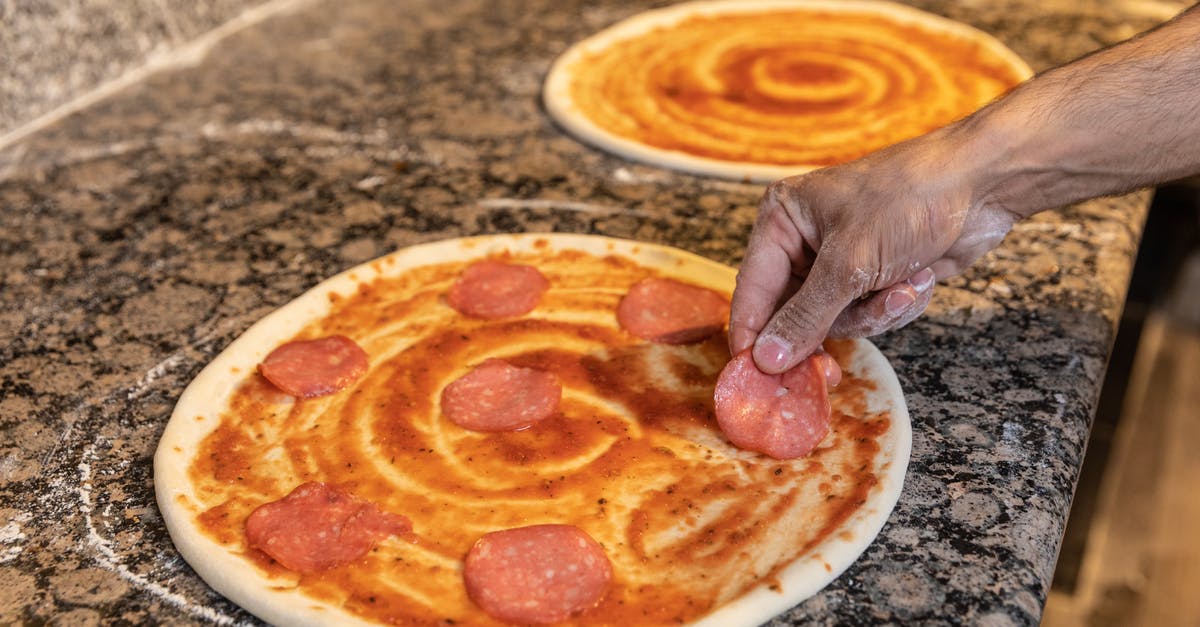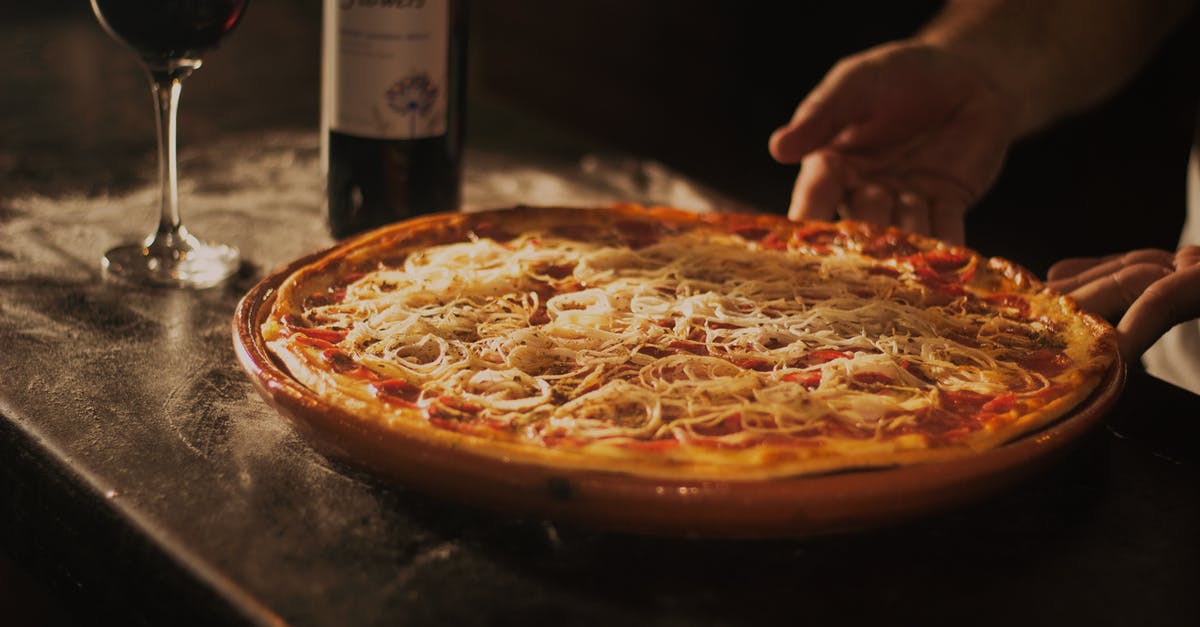How to judge the quality of pizza dough?

What are some good guidelines for judging the consistency and texture of a good pizza dough? I would like to know so I could make some corrections before it's too late!
Maybe some people have some good rules of thumb or neat tricks to share?
I would be more interested in the thin base italian style. The thinner the better and the bigger the bubbles on the edge the better!
Best Answer
My targets for the final dough:
- when I stretch it over my fist, once it has got to the size where it covers my whole fist, it starts to stretch under its own weight
- if the inside of the dough is exposed it will stick to hands/surface
- need to use semolina/cornmeal to transfer the pizza around
- contains lots of visible bubbles before stretching, with the dough having enough integrity to stretch the bubbles without losing them.
- can stretch it to be translucent without tearing too much (preferably without tearing at all)
What I look for at different by stages:
I have been making a lot of pizza dough over the last year, experimenting with different amounts of water and kneading techniques. In order to make a very thin base, (on you can stretch so it is translucent) but can still transfer into the oven I make a very wet (60% hydration) dough and either:
No-Knead approach: use small amounts of yeast and salt. Just leave the dough for approx 18 hours. Then put in the fridge, I find it is best after 2 days in the fridge. Because the dough is cold you can easily handle it, although you might need to let it warm up a bit before you can do anything with it.
What I am aiming for is that when I stretch it over my fist, once it has got to the size where it covers my whole fist, it starts to stretch under its own weight.
I expect to see a lot of bubbles, up to 0.5cm in diameter but most smaller, in the dough, but not to be able to pour it out. I will have to scrape it out of the bowl using a wet spatula. and will have to use a light dusting of flour (not too much) to stop it sticking to the surface or my hands. I sometimes let it rise again after shaping (need to at least let it relax for a few minutes) and usually have to add more flour to my hands to do the stretch. Try to use as little extra flour as you can. I usually have to only dust the dough once and lightly before stretching it. If you have to use any more it might be too wet or not have enough gluten development.
Hand Knead approach: using more yeast and salt. When I first turn the dough out to knead I do not expect to be able to handle it, it is to sticky and runny. I use tools to fold it a few times. You will probably need some flour to do this, but try not to use too much. After several folds the dough comes together enough for me to lightly cover it in flour I "roll knead" - which is rolling and stretching it, but not bringing the wet inside to the surface. If you start to fold or tear the dough it will stick to your hands and the surface, if that happens you have to put more flour on which will reduce the hydration of your dough so avoid it. You will have to work it for quite a while. Try to get your body weight applied to the dough as your roll it.
What I am aiming for is a dough which you can pick up without your fingers just going into it and that springs back when you deform it; but if you tear it or open it up the inside will immediately stick to your hands and the surface. When I get this I stop kneading.
I usually rise it for 80 mins but it depends on the temperature. After this rise, I will divide it and shape it into balls. I expect to not be able to easily rip the dough apart due to its wetness. It should contain quite a bit of air, and some largeish bubbles which I try not to knock back too much.
I have to use a wet spatula to divide it, and then use a small amount of flour on the outside to form a smooth surfaced ball. Then I cover it and rise it again for 20mins. The outside will be smooth with some bubbles visible and due to the flour dry enough to handle. The inside will be too wet to handle without adding more flour.
After this second rise I put a bit of flour on my hands and stretch it over my fist, it should behave pretty much the same as the no-knead version at this stage.
Pictures about "How to judge the quality of pizza dough?"



Quick Answer about "How to judge the quality of pizza dough?"
I find the best pizza dough is relatively wet and unstable. Even after kneading it should still be sticky and bordering on sticking to the board. A wet dough bubbles nicely when you cook it, giving a light, crisp texture.How do you judge pizza dough?
When examining your pizza, make sure to check the bottom and the crust. The bottom should be well done to offer a nice crisp bite, and the crust should be toasted on the outside but fluffy and light on the inside. That's a good indication that the dough was prepared properly and allowed enough time to rise and rest.How do you know if pizza dough is good?
To tell if your pizza dough is bad, remove it from the fridge and inspect it. If it has turned grey, or has specks of grey it is too far gone. Throw it away. Pizza dough that's spoiling turns dry and crusty.How can you tell the quality of a pizza?
How to Identify Good Pizza in 8 Easy StepsWhat texture should pizza dough be?
Your dough will be shaggy and lumpy to begin with, but once you've kneaded it for a while it should be smooth and slightly tacky to touch. If your dough holds it shape and doesn't ooze or sag when you hold it up, that's another good sign that your dough is well kneaded.Pizza 101: Perfectly Proofed Dough
More answers regarding how to judge the quality of pizza dough?
Answer 2
I find the best pizza dough is relatively wet and unstable. Even after kneading it should still be sticky and bordering on sticking to the board. A wet dough bubbles nicely when you cook it, giving a light, crisp texture.
Answer 3
There is also the amount of oil, and how long it mixes. If you want a thin and crispy pizza, you do not want very much water. Around 4 pounds water for 11 pounds of dough. I cant give you specifics because my dough recipes I use are not mine, but rather property of the company I work at (Pizza Hut), but I can tell you do not want wet and unstable dough.
Answer 4
It depends on if you like it thin and crispy or thick and delicate so if its to your taste then go with what you like best and if you are judging it on how it lokks then you would want it to be golden brown crust with melted cheese.
Sources: Stack Exchange - This article follows the attribution requirements of Stack Exchange and is licensed under CC BY-SA 3.0.
Images: Farhad Ibrahimzade, Polina Tankilevitch, Kristina Paukshtite, Edward Eyer
